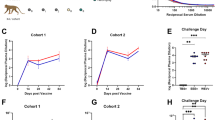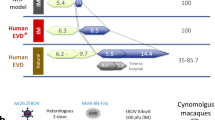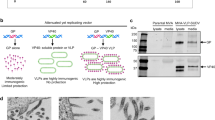Abstract
Outbreaks of haemorrhagic fever caused by the Ebola virus are associated with high mortality rates that are a distinguishing feature of this human pathogen. The highest lethality is associated with the Zaire subtype, one of four strains identified to date1,2. Its rapid progression allows little opportunity to develop natural immunity, and there is currently no effective anti-viral therapy. Therefore, vaccination offers a promising intervention to prevent infection and limit spread. Here we describe a highly effective vaccine strategy for Ebola virus infection in non-human primates. A combination of DNA immunization and boosting with adenoviral vectors that encode viral proteins generated cellular and humoral immunity in cynomolgus macaques. Challenge with a lethal dose of the highly pathogenic, wild-type, 1976 Mayinga strain of Ebola Zaire virus resulted in uniform infection in controls, who progressed to a moribund state and death in less than one week. In contrast, all vaccinated animals were asymptomatic for more than six months, with no detectable virus after the initial challenge. These findings demonstrate that it is possible to develop a preventive vaccine against Ebola virus infection in primates.
This is a preview of subscription content, access via your institution
Access options
Subscribe to this journal
Receive 51 print issues and online access
$199.00 per year
only $3.90 per issue
Buy this article
- Purchase on Springer Link
- Instant access to full article PDF
Prices may be subject to local taxes which are calculated during checkout



Similar content being viewed by others
References
Feldmann, H., Nichol, S. T., Klenk, H. D., Peters, C. J. & Sanchez, A. Characterization of filoviruses based on differences in structure and antigenicity of the virion glycoprotein. Virology 199, 469–473 (1994).
Sanchez, A., Trappier, S. G., Mahy, B. W. J., Peters, C. J. & Nichol, S. T. The virion glycoproteins of Ebola viruses are encoded in two reading frames and are expressed through transcriptional editing. Proc. Natl Acad. Sci. USA 93, 3602–3607 (1996).
Tang, D. C., DeVit, M. & Johnston, S. A. Genetic immunization is a simple method for eliciting an immune response. Nature 356, 152–154 (1992).
Ulmer, J. B. et al. Heterologous protection against influenza by injection of DNA encoding a viral protein. Science 259, 1745–1749 (1993).
Wang, B. et al. Gene inoculation generates immune responses against human immunodeficiency virus type 1. Proc. Natl Acad. Sci. USA 90, 4156–4160 (1993).
Sedegah, M., Hedstrom, R., Hobart, P. & Hoffman, S. L. Protection against malaria by immunization with plasmid DNA encoding circumsporozoite protein. Proc. Natl Acad. Sci. USA 91, 9866–9870 (1994).
Krieg, A. M. et al. CpG motifs in bacterial DNA trigger direct B-cell activation. Nature 374, 546–549 (1995).
Sato, Y. et al. Immunostimulatory DNA sequences necessary for effective intradermal gene immunization. Science 273, 352–354 (1996).
Xu, L. et al. Immunization for Ebola virus infection. Nature Med. 4, 37–42 (1998).
Vanderzanden, L. et al. DNA vaccines expressing either the GP or NP genes of Ebola virus protect mice from lethal challenge. Virology 246, 134–144 (1998).
Connolly, B. M. et al. Pathogenesis of experimental Ebola virus infection in guinea pigs. J. Infect. Dis. 179, S203–S217 (1999).
Bray, M., Davis, K., Geisbert, T., Schmaljohn, C. & Huggins, J. A mouse model for evaluation of prophylaxis and therapy of Ebola hemorrhagic fever. J. Infect. Dis. 178, 651–661 (1998).
Baize, S. et al. Defective humoral responses and extensive intravascular apoptosis are associated with fatal outcome in Ebola virus-infected patients. Nature Med. 5, 423–426 (1999).
Maruyama, T. et al. Ebola virus can be effectively neutralized by antibody produced in natural human infection. J. Virol. 73, 6024–6030 (1999).
Sedegah, M. et al. Boosting with recombinant vaccinia increases immunogenicity and protective efficacy of malaria DNA vaccine. Proc. Natl Acad. Sci. USA 95, 7648–7653 (1998).
Hanke, T. et al. Enhancement of MHC class I-restricted peptide-specific T cell induction by a DNA prime/MVA boost vaccination regime. Vaccine 16, 439–445 (1998).
Robinson, H. L. et al. Neutralizing antibody-independent containment of immunodeficiency virus challenges by DNA priming and recombinant pox virus booster immunizations. Nature Med. 5, 526–534 (1999).
Schneider, J. et al. Enhanced immunogenicity for CD8+ T cell induction and complete protective efficacy of malaria DNA vaccination by boosting with modified vaccinia virus Ankara. Nature Med. 4, 397–402 (1998).
Davis, A. R. et al. Expression of hepatitis B surface antigen with a recombinant adenovirus. Proc. Natl Acad. Sci. USA 82, 7560–7564 (1985).
Natuk, R. J. et al. Adenovirus-human immunodeficiency virus (HIV) envelope recombinant vaccines elicit high-titered HIV-neutralizing antibodies in the dog model. Proc. Natl Acad. Sci. USA 89, 7777–7781 (1992).
Xiang, Z. Q., Yang, Y., Wilson, J. M. & Ertl, H. C. A replication-defective human adenovirus recombinant serves as a highly efficacious vaccine carrier. Virology 219, 220–227 (1996).
Xiang, Z. Q., Pasquini, S. & Ertl, H. C. Induction of genital immunity by DNA priming and intranasal booster immunization with a replication-defective adenoviral recombinant. J. Immunol. 162, 6716–6723 (1999).
Letvin, N. L. et al. Potent, protective anti-HIV immune responses generated by bimodal HIV envelope DNA plus protein vaccination. Proc. Natl Acad. Sci. USA 94, 9378–9383 (1997).
Fisher-Hoch, S. P. et al. Pathophysiology of shock and hemorrhage in a fulminating viral infection (Ebola). J. Infect. Dis. 152, 887–894 (1985).
Wilson, J. et al. Epitopes involved in antibody-mediated protection from Ebola virus. Science 287, 1664–1666 (2000).
Ohno, T. et al. Gene therapy for vascular smooth muscle cell proliferation after arterial injury. Science 265, 781–784 (1994).
Aoki, K., Barker, C., Danthinne, X., Imperiale, M. J. & Nabel, G. J. Efficient generation of recombinant adenoviral vectors by Cre-lox recombination in vitro. Mol. Med. 5, 224–231 (1999).
Ksiazek, T. G. et al. Enzyme immunosorbent assay for Ebola virus antigens in tissues of infected primates. J. Clin. Microbiol. 30, 947–950 (1992).
Kiley, M. P., Regnery, R. L. & Johnson, K. M. Ebola virus: identification of virion structural proteins. J. Gen. Virol. 49, 333–341 (1980).
Acknowledgements
We thank J. DeCoster and R. Grecoe for technical assistance with primates and G. Reynolds for the animal handling in the Biosafety Laboratory-4, K. Reiman and J. Stein for advice, assistance and comments, and N. Barrett, C. Davis and A. Tislerics for help in preparing the manuscript.
Author information
Authors and Affiliations
Corresponding author
Rights and permissions
About this article
Cite this article
Sullivan, N., Sanchez, A., Rollin, P. et al. Development of a preventive vaccine for Ebola virus infection in primates. Nature 408, 605–609 (2000). https://doi.org/10.1038/35046108
Received:
Accepted:
Issue Date:
DOI: https://doi.org/10.1038/35046108
This article is cited by
-
Heterologous prime-boost regimens with HAdV-5 and NDV vectors elicit stronger immune responses to Ebola virus than homologous regimens in mice
Archives of Virology (2021)
-
On the Regional Control of a Reaction–Diffusion System SIR
Bulletin of Mathematical Biology (2020)
-
Anti-Siglec-1 antibodies block Ebola viral uptake and decrease cytoplasmic viral entry
Nature Microbiology (2019)
-
Current Ebola Virus Vaccine Progress
BioDrugs (2019)
-
Post-exposure treatments for Ebola and Marburg virus infections
Nature Reviews Drug Discovery (2018)
Comments
By submitting a comment you agree to abide by our Terms and Community Guidelines. If you find something abusive or that does not comply with our terms or guidelines please flag it as inappropriate.



